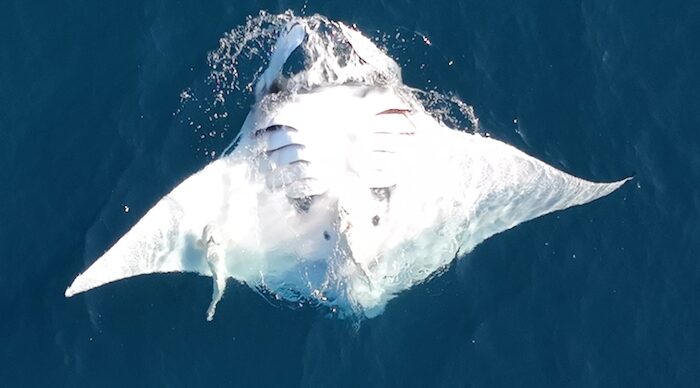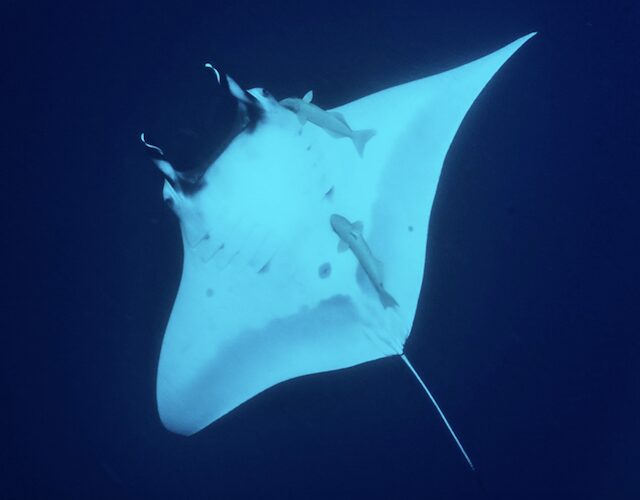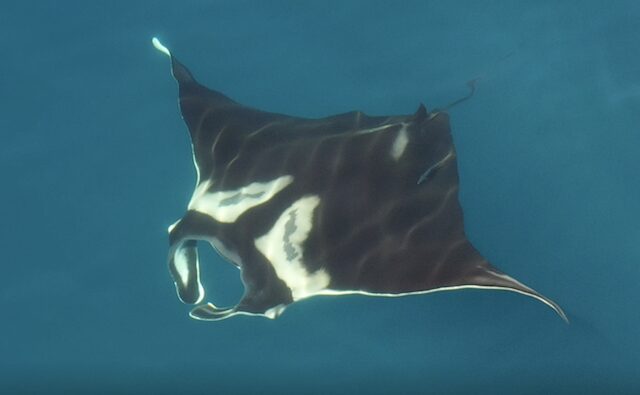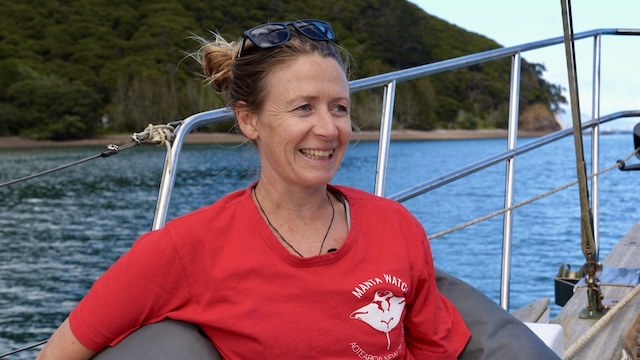Environment: Manta Rays – Giants of Their Kind
The Giant Oceanic Manta Ray is the largest ray in the world, spending most of life far from land, moving with the currents in search of food in tropical and temperate waters. Manta Watch New Zealand is a small charitable trust dedicated to uncovering the many mysteries surrounding these ocean dwellers and in this article Project Director Lydia Green gives an insight into their secret lives.
Published 1 month ago
Reprinted with Permission from Lydia Green and NZ Forest and Bird Magazine
Unlocking the Secret Lives of New Zealand’s Oceanic Manta Rays
Te whai rahi – the giant oceanic manta ray – glides through the water, its large wing- like pectoral fins flapping and undulating, propelling the huge animal efficiently and gracefully through the water.
Mobula birostris is the largest ray in the world, growing up to 7m across (four times the height of me) and weighing up to two tonnes. They spend most of their lives far from land, moving with the currents in search of food in tropical and temperate waters.


They are one of a rare group of animals with a worldwide distribution in both northern and southern hemispheres. They are commercially fished in some places (their gill plates are used in traditional Asian medicine) and protected in others, including in New Zealand’s waters.
Unfortunately, over the last few decades, commercial fishing and bycatch deaths have had a massive impact on the species, leading to their global threat classification of “Endangered and in decline” on the International Union for Conservation of Nature (IUCN) Red List.
The southernmost populations live off Peru, South Africa, and New Zealand. They are often found near offshore oceanic islands, including Tīkapa Moana, Te Moananui-o-toi – the Hauraki Gulf, although until recently little was known about this elusive population.
Lack of data is a big threat to their wellbeing. This is where Manta Watch New Zealand comes in. We are a small charitable trust dedicated to uncovering the many mysteries surrounding Aotearoa’s special te whai rahi population.
In 2020, we set out to answer some key questions, including how and why mantas use New Zealand waters and the kinds of threats they are exposed to during their day-to- day lives.
This project has led to some exciting discoveries. It turns out that New Zealand’s manta rays dive deeper, travel further, and go into colder water than any other manta population in the world. How did we discover this?
Our dedicated Manta Watch NZ research team spent the past five years tracking manta rays in Aotearoa waters, from Northland to the Bay of Plenty. We gathered lots of useful new data in the form of high-quality videos via aerial drones and underwater cameras.


We also collected a host of vital demographic data, including gender, size, injuries, pregnancy, as well as behaviour. The markings on a manta ray’s belly are unique to that individual and remain unchanged over its lifetime. So we’ve been working to identify individual manta rays by collecting their photo IDs.
This means researchers can track individuals over time and gain valuable insights into how a population is structured, as well as estimating its size.
Researching a highly mobile marine species that doesn’t need to come to the surface can be tricky. The project’s research efforts are supplemented by a national manta network – aka hundreds of citizen scientists who submit sightings to the project. We developed a Manta Watch NZ app so people can record sightings, key facts, and videos and images.


This collective manta work provided invaluable insight into seasonal distributions and habitat use. Moreover, real-time and historic sightings helped the team focus their manta survey efforts, increasing overall encounter success.
Satellite tagging has also been a vital tool in accelerating our understanding of how mantas are using their habitat, horizontally and vertically. They exhibit two distinct modes – feeding and migrating. Our inshore waters serve as important seasonal feeding grounds. Individuals have been tracked moving between regions in search of kai, spending most of their time within the top 5m and feeding on dense swarms of krill.
Tagging data has also confirmed that at least a proportion of New Zealand’s manta population seasonally migrate out of our waters into the wider Southwest Pacific. More than 70% of mantas tagged left New Zealand waters around late summer and early autumn, heading towards Fiji and Tonga.
While on the move, New Zealand’s mantas have redefined what we previously thought the species was capable of doing – they dive deeper (1400m), travel further (4500 km in 52 days), and venture into colder water (3.5°C) than any other manta population has been shown to do!
Conservation Wins
The data and knowledge gains achieved through our Manta Watch NZ project have enabled the New Zealand Threat Classification Status for oceanic manta rays to be upgraded from Data Deficient to Nationally Vulnerable. We also gained Important Shark and Ray Area status for a total of 445,546.4km2 ocean habitat.
This includes the Hauraki Gulf Marine Park as an important feeding area, and the newly defined migratory corridor between New Zealand, Fiji, and Tonga as an important movement area. These two wins set the foundation for greater species and ecosystem conservation management in New Zealand and the Pacific. By establishing greater protections for our oceanic manta rays, entire marine ecosystems will benefit.
Our next steps will be studying the population’s genetics, potential nursery areas, and investigating the threats our mantas face when migrating out of New Zealand’s Exclusive Economic Zone into the high seas.


Fascinating Facts
Giant oceanic manta rays have only been protected in New Zealand waters since 2011. It is illegal to hunt, kill, or harm them. If caught by mistake, they must be released alive and unharmed.
Te whai rahi are essentially flat sharks and share key attributes, for example they have dermal denticles (tiny teeth) instead of scales and a light, flexible skeleton made of cartilage instead of bone. They can only travel forward and cannot reverse out of fishing nets.
Oceanic manta rays have the largest brain of any fish and also one of the most conservative life histories of all shark and ray species. They are slow growing, long lived (at least 40 years), and late to reach sexual maturity. They typically only give birth to one pup at a time, after an extensive 12.5-month gestation period.
Like all marine life, te whai rahi is impacted by climate change. Changes in sea surface temperatures and other climate-related phenomena, such as El Niño, can affect their distribution, food supply, and potentially their survival.
Put that all together, and you have yourself a highly vulnerable species whose populations really cannot cope with any form of fishing exploitation.
Lydia Green
Founder and Project Director
Manta Watch New Zealand.


On Passage Between NZ and the Pacific Islands?
Your help is needed! Manta Watch NZ is conducting vital research on New Zealand’s Oceanic Manta and Spinetail Devil Rays. If you’ve ever encountered either species in NZ waters or on your way to and from the islands they would love to hear from you. Many rays migrate into the wider SW Pacific between mid-autumn and early winter towards and beyond Fiji and Tonga, returning to NZ in early/mid spring. Real time and historic sightings can easily be submitted by downloading the free Manta App. Sharing your sightings with the project will directly contribute towards the future conservation of these globally endangered species.
About Manta Watch New Zealand
Lydia Green, the founder and project director is an experienced marine ecologist and has worked with manta rays since 2013, researching manta ray populations in Fiji, Mexico, the Maldives and New Zealand. Lydia founded Manta Watch New Zealand Charitable Trust and has been Project Manager since 2017. She has extensive knowledge of oceanic manta rays in NZ waters and manages the project’s national sightings and photo identification databases. Lydia is an experienced marine educator and is MWANZ’s primary contact for community engagement and outreach programs.
Manta Watch New Zealand’s research partners include Conservation International Aotearoa, the University of Auckland, the Department of Conservation and the Tindall Research Charitable Trust.
The organisation is funded by Whakatupu Aotearoa Foundation, Live Ocean Foundation, Manta Trust, and Pub Charity Ltd.
…………………………………
Related Links:
- Manta Watch Aotearoa New Zealand
- International Union for Conservation of Nature (IUCN) Red List.
- Report a Sighting
…………………………………
© 2025 Do not reproduce without permission. All rights reserved. Reprinted with Permission from Lydia Green and NZ Forest and Bird Magazine
The opinions expressed in this article are the author’s own and do not reflect the view of Noonsite.com or World Cruising Club.
If you have found this information useful, become a paid member to enjoy unlimited use of Noonsite plus many other perks. Your membership fees really help our small, dedicated team keep country information up-to-date in support of cruisers worldwide. Find out more about Noonsite Membership levels and benefits here.
Subscribe to our FREE monthly newsletter: https://www.noonsite.com/newsletter/
Related to the following Cruising Resources: Citizen Science, Environment, General, Pacific, Pacific Crossing, Pacific Ocean South, Rallies, Routing




